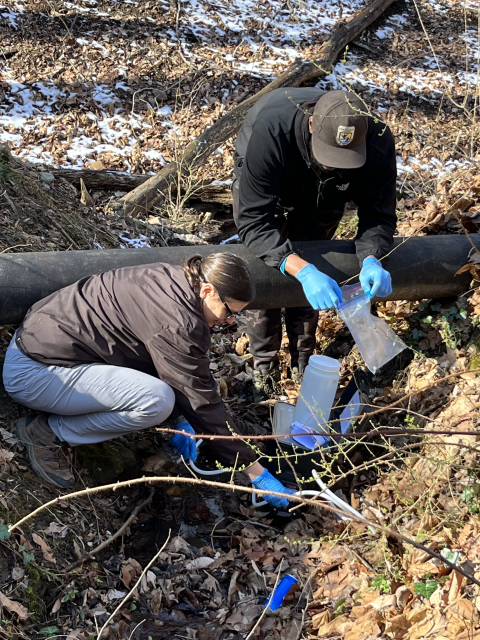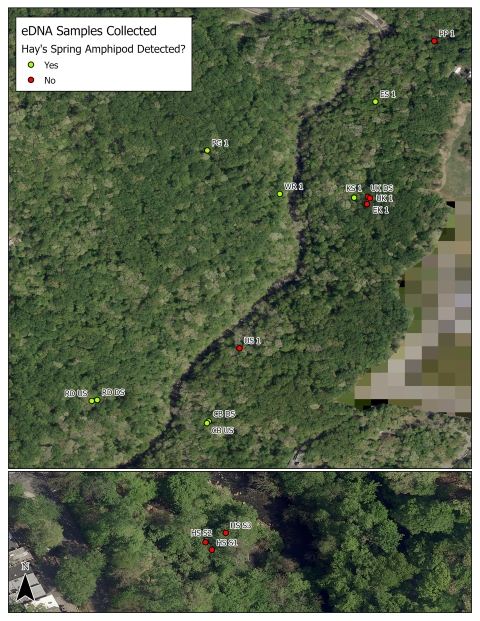Sometimes scientists trek to remote areas to discover new species. Sometimes they find them outside of a zoo.
That’s where the Hay’s spring amphipod turned up more than eighty years ago. It was discovered at the south end of the Smithsonian’s National Zoological Park in Washington, D.C.’s, Rock Creek Park.
Since then, the tiny groundwater-dwelling crustacean — which is now protected under the Endangered Species Act — has largely eluded detection.
With no way to access its groundwater habitat, scientists survey for the rare amphipod in seasonal springs in Rock Creek Park on the rare chance that a specimen will wash up.
So how do you monitor an amphipod that you can't find? Technology now has an answer.
Diamond in the rough
Midway through his freshman year of high school, Leslie Hubricht dropped out to help provide for his family. He would eventually make up for lost time in the classroom.
When Hubricht was 28, he got a job as a research assistant for botanist Edgar Anderson at the Missouri Botanical Garden and devoted himself to the study of plants, mollusks, isopods, and amphipods.
Over the course of a long career as a self-made naturalist, he authored more than 150 scientific papers and described dozens of new species, including the Hay’s spring amphipod.
In 1938, Hubricht discovered the tiny, colorless, groundwater-dwelling crustacean at the outlet of a small spring outside of the National Zoo. He named it for Dr. William Perry Hay — a local high school biology teacher.
More than four decades after Hubricht’s discovery, only a couple dozen more specimens had been collected, all from the same spring near the National Zoo. Citing the species’ sensitivity to development and changes in water quality, and its alarmingly small population, the U.S. Fish and Wildlife Service listed the Hay’s spring amphipod as endangered in 1982.
As the New York Times declared upon the announcement, “The nation's capital now has its very own endangered species.”
Needle in a haystack
Since its listing, the Hay’s spring amphipod has been documented at seven additional sites, all within the protected lands of Rock Creek Park, a unit of the National Park Service.
But the species has continued to be elusive because it rarely appears on the surface.
The Hay’s spring amphipod makes its home in subterranean aquatic habitats — small reservoirs beneath the ground perched above a layer of clay, isolating them from the water table below. In the winter, when the water table rises, small springs flow to the surface. Occasionally, amphipods wash out.
“You have to search carefully in the leaf litter in saturated areas to find them,” explained Kathleen Cullen, the species lead for the Service. Even if you do come upon a tiny, pale, shrimp-like creature, she said, “It might not be a Hay’s spring amphipod — there are other species it’s easy to confuse with.”
Fortunately, biologists now have a tool that can help them detect Hay’s spring amphipods, even when they can’t find them.
The science of deduction
In February and March 2021, biologists from the Service’s Chesapeake Bay Field Office collected 16 water samples at 11 spring sites within Rock Creek Park using a small, mechanical pump.
After filtering the samples to remove forest debris, they sent them to the Service’s Northeast Fishery Center in Lamar, Pennsylvania, to be analyzed for environmental DNA — eDNA for short.
“It’s a process that lets us detect an organism in a sample of water when the organism is not physically there,” explained Aaron Maloy, a geneticist at the Northeast Fishery Center who ran the analyses. “We are looking for traces left behind in the environment.”
Those traces can come from anything that’s secreted or shed by an organism, including feces, muous, skin cells, and hair.
“When we get a water sample, we pull out DNA from everything that’s there — bacteria, decomposing leaf litter, and potentially, amphipods,” Maloy said. “At that point, we have to sort through and find the DNA we are looking for — a piece that came from the amphipod.”
That means the process needs to start with an actual specimen — ideally several — so you can pinpoint the DNA you are trying to match.
A snapshot
Once you have that baseline DNA in hand, eDNA offers an efficient and cost-effective way to get a snapshot of a species’ likely occurrence, which is particularly useful when surveying for aquatic species across broad geographies.
“It’s more economical to send one person out to take water samples at a number of different sites than to send crews of people to conduct physical surveys for fish or mussels,” Maloy said.
It also minimizes habitat disturbances that could result from repeated surveys.
Importantly, eDNA is not a substitute for traditional surveys. “What we detect is the organism’s DNA – not the organism,” Maloy said. “We assume that means it’s there, but that’s not always the case.”
Because the analysis is so sensitive, it could pick up traces of DNA that were deposited from another source — say if a bird eats the organism, and then poops in a stream.
But it does help managers prioritize where to invest limited resources on the ground.
While eDNA has been growing in popularity for surveying fish and mussel species, the use of this technology for detecting elusive, groundwater-dwelling species is about as common as the Hay’s spring amphipod.
“This is a novel application,” Maloy said. “Not a lot of eDNA work has been done on crustaceans in general, especially in this type of habitat.”
Positive signs
The eDNA analyses resulted in positive detections in eight samples collected at six sites. Two of the sites were previously considered to be of "unknown" or "probable" status — meaning biologists weren't confident the species was there at all. Now they know those sites are worth another look.
This March, biologists conducted additional eDNA surveys at six sites: four that were surveyed in 2021 with no detections, and two where Hay’s spring amphipod has not yet been found. Those results aren’t in yet.
Next winter, the Virginia Department of Conservation and Recreation will recheck the sites by doing traditional surveys — sifting through wet leaf litter in search of the amphipod specimens — with help from the Service.
“We need to do those surveys to help validate the eDNA results,” Cullen said. “Just because a water sample from a spring indicates it’s not occupied doesn’t mean there aren’t Hay’s spring amphipods in the groundwater habitat below that could wash up.”
The springs are a source of clues about how the species is doing. But the health of the Lower Rock Creek watershed is the key to its future.
Spring-keepers
When the Hay’s spring amphipod was listed in the early 1980s, management options were so limited that the Service determined a recovery plan would not be beneficial.
Now that’s changed, thanks to advances in both technology and our understanding of the species. This winter, the Service released a draft recovery plan identifying objective, measurable criteria for removing the amphipod from the endangered species list, and site-specific actions managers can take to promote recovery.
Since climate change climate change
Climate change includes both global warming driven by human-induced emissions of greenhouse gases and the resulting large-scale shifts in weather patterns. Though there have been previous periods of climatic change, since the mid-20th century humans have had an unprecedented impact on Earth's climate system and caused change on a global scale.
Learn more about climate change could lead to more-frequent storm events, increasing the magnitude and severity of threats to the species by impacting water quality and water quantity, there’s no time to waste.
But now we know what to do about it. Like keeping the urban forest healthy to provide amphipods adequate nutrients through decaying leaves and organic matter, and to regulate water quality, quantity, and temperature.
And reducing stormwater runoff from impervious surfaces like parking areas.
We’re already making progress. The D.C. Department of Energy and Environment, Smithsonian Institution, and National Park Service recently collaborated on a project to retrofit 11 acres of pavement around the Fitzgerald Tennis Center in Rock Creek Park with nature-based bioretention structures.
Projects like that benefit not only the Hay’s spring amphipod, but any species in the area that relies on clean water — including us.
That wouldn’t be news to Hubricht.
When he published his discovery of the Hay’s spring amphipod in The American Midland Naturalist in 1940, he described several other species of freshwater crustaceans he’d collected. In the description of one from Jefferson County, Missouri, Hubricht noted that amphipods were called "spring-keepers" by one resident of the Ozarks, “who believed water from a spring to be impure and unfit for drinking unless it contained them.”
D.C.’s own spring-keeper is now on the path to recovery.







